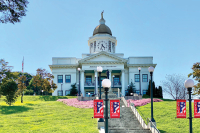No limits
A chandelier over a high-limit gaming table at Harrah’s Cherokee Casino costs $150,000, more than the median selling price of homes in Western North Carolina last year.
Like all the luxury touches found in the casino, it was custom designed. Carpets weren’t picked from swatches. And you won’t find the light fixtures in a catalogue. A team of interior designers invented everything from scratch and had them manufactured to order.
They exude class. On average, the casino’s interior finishes cost $250 a square foot. The tile mosaics on giant columns are real slate. Any paneling is real wood.
“They didn’t skimp on quality at all. When people come in here and play, they look at finishes. They look at décor. If it looks cheap their perception is going to be this was just thrown together,” said Matt Pegg, executive director of the Cherokee Chamber of Commerce.
But in some spaces, such as the posh Asian gaming room — boasting a traditional moon gate over the entrance, thought to bring wealth to those who pass through it — interiors ran as much as $600 a square foot.
If dropped in to Harrah’s blindfolded, the glitz and glam could easily place you in Vegas. But behind the veil, the subtle influence of color and design leave no doubt this casino is in Indian Country.
Related Items
“In the beginning, we created a story, what I call the backbone, of the entire casino,” said Michelle Espeland, the lead interior designer.
Native American themes had to be present, but not “in your face,” Espeland said. “It has derivatives of Native American influence, but not over the top.”
Cherokee art with highly literal images once decorated the hotel rooms and corridors. The new art package, as they call it, is much more subtle in its native themes.
Espeland was one of nine interior designers at the project’s peak working for The Cunningham Group, the architect firm over the casino expansion.
Common threads run through the casino, from the hotel’s front desk to the shopping concourse. But such a large, sprawling space needed variation, too.
Themes define four blocks within the casino: Mountain Breeze, Woodland Moon, River Valley and Earth Water. The interiors team devoted an entire wall of their office to a creative board, papering it with key words and adjectives that related to each theme.
Set into the ceiling above gaming tables in Woodland Moon, lighting shines through yellow glass set in a tangle of wooden beams, meant to convey dappled light filtering through tree branches. In Earth Water, a light display covers a three-story wall to give the sensation of falling water drops.
Also part of the Earth-Sky zone, the 600-seat buffet has a soaring ceiling bulging with angular rust red boulders. A giant two-story marble slab on one wall is inlaid with jagged, elongated mirrors representing fissures in a rock face.
“It’s the notion of being in a geologic formation,” said Erik Sneed, construction manager of the project. He pointed out the ceiling overhead dotted with constellations.
 The finer points of design are so imbedded throughout the casino, it’s impossible to discover them all. Even the newly-opened food court, featuring a Dunkin Donuts, Boar’s Head deli counter and the like, is so polished that “food court” is hardly the right name for it.
The finer points of design are so imbedded throughout the casino, it’s impossible to discover them all. Even the newly-opened food court, featuring a Dunkin Donuts, Boar’s Head deli counter and the like, is so polished that “food court” is hardly the right name for it.
“Of course, we did it with typical casino flare — spent a fortune on all the fixtures,” Sneed said.
Pegg thinks it was the right call.
“We’ve all been to that place that is supposed to be great but you get there and it is only alright,” Pegg said. “Here, there is going to be that ‘wow’ factor. People will want to come back again and again.”









